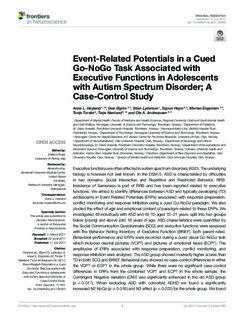| dc.contributor.author | Høyland, Anne Lise | |
| dc.contributor.author | Øgrim, Geir | |
| dc.contributor.author | Lydersen, Stian | |
| dc.contributor.author | Hope, Sigrun | |
| dc.contributor.author | Engstrøm, Morten | |
| dc.contributor.author | Torske, Tonje | |
| dc.contributor.author | Nærland, Terje | |
| dc.contributor.author | Andreassen, Ole Andreas | |
| dc.date.accessioned | 2017-08-10T06:47:54Z | |
| dc.date.available | 2017-08-10T06:47:54Z | |
| dc.date.created | 2017-07-11T11:51:42Z | |
| dc.date.issued | 2017 | |
| dc.identifier.citation | Frontiers in Neuroscience. 2017, 11 (393), . | nb_NO |
| dc.identifier.issn | 1662-4548 | |
| dc.identifier.uri | http://hdl.handle.net/11250/2450347 | |
| dc.description.abstract | Executive functions are often affected in autism spectrum disorders (ASD). The underlying biology is however not well known. In the DSM-5, ASD is characterized by difficulties in two domains: Social Interaction and Repetitive and Restricted Behavior, RRB. Insistence of Sameness is part of RRB and has been reported related to executive functions. We aimed to identify differences between ASD and typically developing (TD) adolescents in Event Related Potentials (ERPs) associated with response preparation, conflict monitoring and response inhibition using a cued Go-NoGo paradigm. We also studied the effect of age and emotional content of paradigm related to these ERPs. We investigated 49 individuals with ASD and 49 TD aged 12–21 years, split into two groups below (young) and above (old) 16 years of age. ASD characteristics were quantified by the Social Communication Questionnaire (SCQ) and executive functions were assessed with the Behavior Rating Inventory of Executive Function (BRIEF), both parent-rated. Behavioral performance and ERPs were recorded during a cued visual Go-NoGo task which included neutral pictures (VCPT) and pictures of emotional faces (ECPT). The amplitudes of ERPs associated with response preparation, conflict monitoring, and response inhibition were analyzed. The ASD group showed markedly higher scores than TD in both SCQ and BRIEF. Behavioral data showed no case-control differences in either the VCPT or ECPT in the whole group. While there were no significant case-control differences in ERPs from the combined VCPT and ECPT in the whole sample, the Contingent Negative Variation (CNV) was significantly enhanced in the old ASD group (p = 0.017). When excluding ASD with comorbid ADHD we found a significantly increased N2 NoGo (p = 0.016) and N2-effect (p = 0.023) for the whole group. We found no case-control differences in the P3-components. Our findings suggest increased response preparation in adolescents with ASD older than 16 years and enhanced conflict monitoring in ASD without comorbid ADHD during a Go-NoGo task. The current findings may be related to Insistence of Sameness in ASD. The pathophysiological underpinnings of executive dysfunction should be further investigated to learn more about how this phenomenon is related to core characteristics of ASD. | nb_NO |
| dc.language.iso | eng | nb_NO |
| dc.publisher | Frontiers Media | nb_NO |
| dc.rights | Navngivelse 4.0 Internasjonal | * |
| dc.rights.uri | http://creativecommons.org/licenses/by/4.0/deed.no | * |
| dc.title | Event-Related Potentials in a Cued Go-NoGo Task Associated with Executive Functions in Adolescents with Autism Spectrum Disorder; A Case-Control Study | nb_NO |
| dc.type | Journal article | nb_NO |
| dc.type | Peer reviewed | nb_NO |
| dc.description.version | publishedVersion | nb_NO |
| dc.source.pagenumber | 13 | nb_NO |
| dc.source.volume | 11 | nb_NO |
| dc.source.journal | Frontiers in Neuroscience | nb_NO |
| dc.source.issue | 393 | nb_NO |
| dc.identifier.doi | https://doi.org/10.3389/fnins.2017.00393 | |
| dc.identifier.cristin | 1481885 | |
| dc.description.localcode | © 2017 Høyland, Øgrim, Lydersen, Hope, Engstrøm, Torske, Nærland and Andreassen. This is an open-access article distributed under the terms of the Creative Commons Attribution License (CC BY). The use, distribution or reproduction in other forums is permitted, provided the original author(s) or licensor are credited and that the original publication in this journal is cited, in accordance with accepted academic practice. No use, distribution or reproduction is permitted which does not comply with these terms. | nb_NO |
| cristin.unitcode | 194,65,35,0 | |
| cristin.unitcode | 194,65,30,0 | |
| cristin.unitname | Regionalt kunnskapssenter for barn og unge - Psykisk helse og barnevern | |
| cristin.unitname | Institutt for nevromedisin | |
| cristin.ispublished | true | |
| cristin.fulltext | original | |
| cristin.qualitycode | 1 | |

